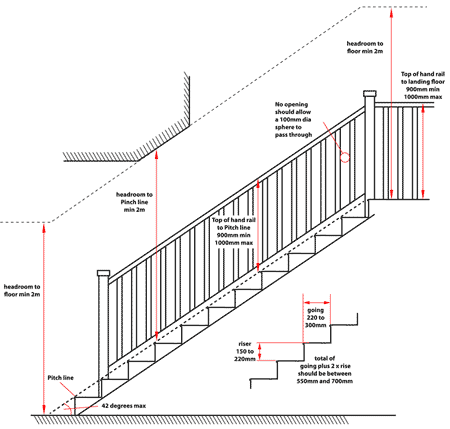Staircases - design requirements
Building Regulations Part K (Protection from falling, collision and impact) covers the design of staircases, this article looks at how these regulations and other design issues apply to staircases in domestic dwellings.
The figure below shows the basic dimensional constraints, click on the image for a larger copy.
Note the pitch line across the front of each tread - this line is used for various measurements.
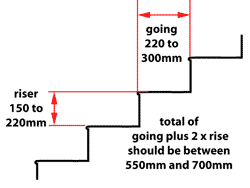 For the individual treads:
For the individual treads:
- Each 'going' must be level
- The size of each 'going' and 'riser' in a flight of stairs must be consistent.
- The goings must be between 220 and 300mm
- The risers must be between 150 and 220mm
- The total of a going plus 2 risers should be between 550 and 700mm
- The maximum angle of the stairs (as measured between the pitch line and the horizontal) is 42 degrees
For all parts of the staircase where the vertical drop is 600mm or greater, a handrail must be provided between 900 and 1000mm above the pitch line or, on a landing, the floor. Where the stairs are 1000mm wide or more, a handrail should be mounted on both sides. The 600mm vertical drop usually means that at least the bottom two step need not have a handrail, and this allows for some architectural design of the bottom step as illustrated below.
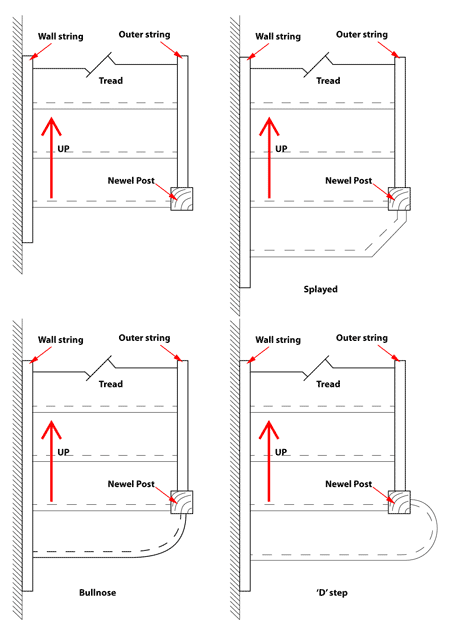
No part of the staircase where there is a vertical drop of 600mm or greater must allow a 100mm sphere to pass through. The closing under the handrail should not be horizontal rails, as this would make it easy for children to climb over the handrail.
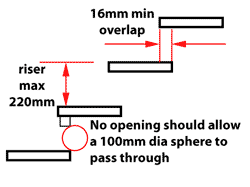 Open treads are acceptable for single dwelling (i.e. not flats) providing that the treads overlap by at least 16mm and that a sphere 100mm diameter cannot pass through between the treads - the latter can be achieved by 'battens' under the upper tread or other obstructions introduced into the design.
Open treads are acceptable for single dwelling (i.e. not flats) providing that the treads overlap by at least 16mm and that a sphere 100mm diameter cannot pass through between the treads - the latter can be achieved by 'battens' under the upper tread or other obstructions introduced into the design.
Building Regulations Part K does not specify the width of stairs for dwellings, however it is generally accepted that:
- From ground floor to first floor with multiple rooms - 800 to 950mm.
- For lost conversions of one or two rooms - 600 to 750mm.
The width chosen may be a design choice dependant on the size of the rest of the dwelling - a stairway in a narrow hallway will need to be on the narrow side, from both a practical and esthetic point of view.
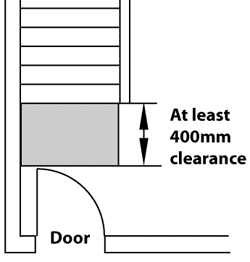 Landings should be at least as long and as wide as the width of the staircase. The opening arc of any door on the landing should clear the end of the stairs by at least 400mm.
Landings should be at least as long and as wide as the width of the staircase. The opening arc of any door on the landing should clear the end of the stairs by at least 400mm.
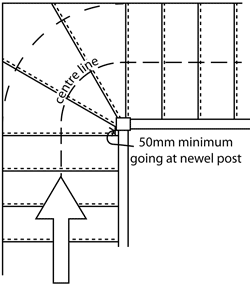 A staircase can be designed to turn a corner using tapered treads (see right). The going for these treads is measured at the centre line as shown, it must be:
A staircase can be designed to turn a corner using tapered treads (see right). The going for these treads is measured at the centre line as shown, it must be:
- between 220 and 300mm.
- at least as wide as the goings of the straight treads in the flight.
- the same for each tapered tread.
The tapered treads must be at least 50mm at the narrowest (i.e. adjacent to the Newel Post).
The risers for the tapered treads must be between 150 and 220mm.
Using tapered treads at a turn removes the need for a landing and will reduce the amount of space needed for the staircase.

